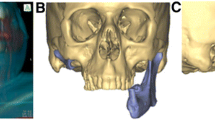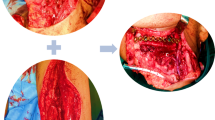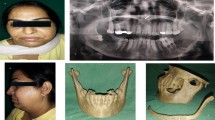Abstract
Objective
To assess the feasibility of the use of 3-dimensional (3-D) stereolithographic (SLA) technology in complex maxillofacial reconstructive surgery.
Materials and Methods
3-D SLA technology was used in the treatment planning of complex maxillofacial procedures performed by the Department of Oral and Maxillofacial Surgery at Boston University. Specialized 3-D models were ordered and utilized for surgical treatment of a variety of indications including trauma surgery, temporomandibular joint surgery, orthognathic surgery, secondary correction of facial and skull deformities, and extensive jaw pathology. This technology was also used in one patient for jaw reconstruction using novel bone and tissue engineering techniques.
Results
The use of 3-D models in Oral and Maxillofacial Surgery significantly improved predictability of clinical outcomes when compared to similar treatments without its use. Total operating time was reduced which had the benefit of decreasing the duration of general anesthesia and reducing wound exposure time. They allowed for assessment of extensive traumatic and pathologic defects in three-dimensions prior to surgical reconstruction. The models were also useful in the design and fabrication of custom prostheses, sizing of bone grafts and allowed for manufacturing of scaffolds for bone regeneration.
Conclusions
3-D SLA models can be very effectively used in oral and maxillofacial surgery for multiple indications and diverse clinical scenarios. Successful incorporation of this technology for jaw bone regeneration using tissue engineering techniques offers exciting new prospects for the future.






Similar content being viewed by others
References
Cunningham L, Madsen M, Peterson G (2005) Stereolithographic modeling technology applied to tumor resection. J Oral Maxillofac Surg 63:873–878
Chow L, Cheung L (2007) The usefulness of stereomodels in maxillofacial surgical management. J Oral Maxillofac Surg 65:2260–2268
Wong T, Fang J, Chung C, Huang J, Lee J (2005) Comparison of 2 methods of making surgical models for correction of facial asymmetry. J Oral Maxillofac Surg 63:200–208
Mazzoli A, Germani M, Moriconi G (2007) Application of optical digitizing techniques to evaluate the shape accuracy of anatomical models derived from computer tomography data. J Oral Maxillofac Surg 65:1410–1418
Schicho K, Figl M, Seemann R, Ewers R, Lambrecht JT, Wagner A, Watzinger F, Baumann A, Kainberger F, Fruehwald J, Klug C (2006) Accuracy of treatment planning based on stereolithography in computer assisted surgery. Med Phys 33(9):3408–3417
Fruhwald J, Schicho KA, Figl M, Benesch T, Watzinger F, Kainberger F (2008) Accuracy of craniofacial measurements: computed tomography and three-dimensional computed tomography compared with stereolithographic models. J Craniofac Surg 19(1):22–26
Barker TM, Earwaker WJS, Lisle DA (1994) Accuracy of stereolithographic models for human anatomy. Australas Radiol 38:106
Choi JY, Choi JH, Kim NK et al (2002) Analysis of errors in medical rapid prototyping models. Int J Oral Maxillofac Surg 31:23
Wolford L, Mehra P (2001) Simultaneous temporomandibular joint and mandibular reconstruction in an immunocompromised patient with rheumatoid arthritis: a case report with 7-year follow-up. J Oral Maxillofac Surg 59:345–350
Author information
Authors and Affiliations
Corresponding author
Rights and permissions
About this article
Cite this article
Mehra, P., Miner, J., D’Innocenzo, R. et al. Use of 3-D Stereolithographic Models in Oral and Maxillofacial Surgery. J. Maxillofac. Oral Surg. 10, 6–13 (2011). https://doi.org/10.1007/s12663-011-0183-3
Received:
Accepted:
Published:
Issue Date:
DOI: https://doi.org/10.1007/s12663-011-0183-3




